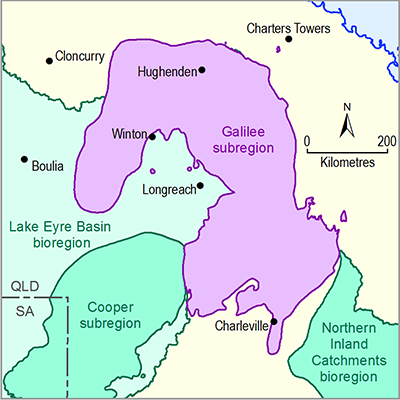- Home
- Assessments
- Bioregional Assessment Program
- Galilee subregion
- 2.6.2 Groundwater numerical modelling for the Galilee subregion
- 2.6.2.3 Model development
- 2.6.2.3.5 Geometry and hydrostratigraphy
2.6.2.3.5.1 Hydrostratigraphy
The groundwater system is implemented as an alternating sequence of aquifers and aquitards, represented by seven model layers. Groundwater level and flow will only be simulated for the aquifers. The flow between two successive aquifers will be controlled by the hydraulic gradient between them and the hydraulic properties assigned to the aquitard separating both aquifers. A summary of the hydrostratigraphic units simulated by the GW AEM and their corresponding model layers are shown in Table 11. Companion product 2.1-2.2 for the Galilee subregion (Evans et al., 2018a) provides further detail on the thickness and distribution of the various hydrostratigraphic units outlined in Table 11.
The layer representing Cenozoic sediments is an equivalent to layers representing ‘Tertiary sediments’ in the mine-scale groundwater models (see Section 2.6.2.2). The Cenozoic aquitard layer represents the weathering that occurred in the early Cenozoic and resulted in a kaolinised weathering profile (see Section 1.1.3.2.3 in companion product 1.1 (Evans et al., 2014)).
Unlike in most mine-scale hydrogeological numerical models, the upper Permian coal measures are simulated as a single aquifer layer. Simulating the individual seams was deemed not justified as the data are not available to establish their presence and thickness throughout the entire model domain and because the pumping rates reported by mining companies do not provide sufficient detail to partition the pumping between the different seams. In Section 2.6.2.8.2.4 it is shown that this approach leads to an underestimate of drawdown in the coal seam, but over estimates drawdown at the base of the Rewan Group aquitard.
Although there are no model nodes associated with the Joe Joe Group, it is included in the numerical model as the cone of depression in the upper Permian coal measures can propagate into this hydrostratigraphic unit. The Joe Joe Group is separated into two layers, an upper aquitard and an aquifer. The upper aquitard represents the impedance to flow between the upper Permian coal measures and the Joe Joe Group due to coal interburden layers. The Joe Joe Group aquifer is assigned a nominal thickness of 100 m to recognise that it is very unlikely that the entire Joe Joe Group is acting as a vertically homogeneous aquifer contributing evenly to groundwater flow. Representing the entire formation thickness would result in a very high transmissivity and storage. This would provide the model with a source of water that is unlikely to be mobilised and therefore representing the entire thickness would lead to an underestimate of drawdown.
Table 11 Hydrostratigraphy and corresponding model layers used for the groundwater analytic element model (GW AEM) for the Galilee subregion
2.6.2.3.5.2 Model geometry
The model layers are of infinite lateral extent, horizontal, with constant thickness (Figure 9b). The top of the model is set to an arbitrary level of zero metres and the total thickness of the simulated sedimentary column is 600 m.
The geological cross-section in Figure 7 does indicate that the hydrostratigraphic units in the Galilee Basin dip towards the west, basin-inwards, and that the thickness of these units is variable. The change in a confined groundwater system depends on the transmissivity of the aquifers and leakage of aquitards. Changes in slope and thickness are therefore only important insofar that they affect transmissivity and leakage. As detailed in the parameterisation section of this product (Section 2.6.2.6), all uncertainty regarding the transmissivity and leakage is transferred to the uncertainty in the hydraulic conductivity. Section 7.1 in companion submethodology M07 (as listed in Table 1) for groundwater modelling (Crosbie et al., 2016) discusses in greater detail how the assumption of uniform hydraulic parameters in combination with the stochastic approach will not lead to an underestimate of drawdown.
The Cenozoic and alluvial deposits are not continuous, have a high variability in thickness and are unconfined. Despite the assumption that the layer is of uniform thickness and of infinite extent is not an entirely accurate representation of reality, it is justified as it will lead to an overestimate of the extent of the hydrological change. It will be possible for the groundwater model to predict drawdown in locations beyond the boundary of the Cenozoic cover, where these sediments, in fact, are not present. Within the boundaries of the Cenozoic cover, however, the magnitude of drawdown potentially is under estimated. The boundaries of the Cenozoic cover can be thought of as impermeable boundaries, and pumping close to impermeable boundaries will lead to larger drawdowns than when these boundaries are not present (Kruseman and de Ridder, 1994).
This conceptualisation of the Cenozoic cover is nevertheless considered justified as it will lead to an overestimate of the number of model nodes that are potentially affected, although locally drawdown will be under estimated.

Product Finalisation date
- 2.6.2.1 Methods
- 2.6.2.2 Review of existing models
- 2.6.2.2.1 Alpha and Kevin's Corner model review
- 2.6.2.2.2 Carmichael model review
- 2.6.2.2.3 China First model review
- 2.6.2.2.4 China Stone model review
- 2.6.2.2.5 South Galilee model review
- 2.6.2.2.6 Galilee Basin hydrogeological model review
- 2.6.2.2.7 Suitability of existing groundwater models
- References
- Datasets
- 2.6.2.3 Model development
- 2.6.2.4 Boundary and initial conditions
- 2.6.2.5 Implementation of the coal resource development pathway
- 2.6.2.6 Parameterisation
- 2.6.2.7 Observations and predictions
- 2.6.2.8 Uncertainty analysis
- 2.6.2.9 Limitations and conclusions
- Citation
- Acknowledgements
- Currency of scientific results
- Contributors to the Technical Programme
- About this technical product
